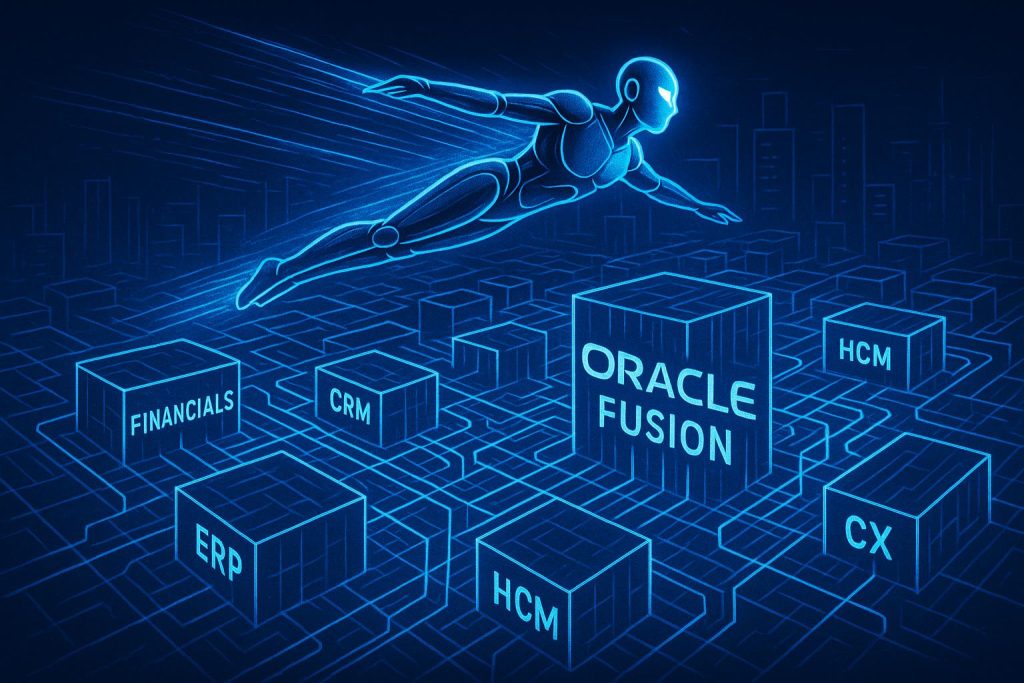Listen to the article
Oracle introduces a comprehensive AI-first strategy, integrating predictive and autonomous AI agents into its Fusion SaaS applications to revolutionise business workflows and accelerate innovation.
Oracle is advancing a comprehensive “AI-first” strategy, positioning artificial intelligence as an inherent component of its entire product ecosystem rather than a peripheral addition. This approach integrates AI seamlessly into existing workflows, eliminating the need for separate integration efforts or conversion programmes. According to Oracle, over 200 predictive, generative, and agent-based AI functions are now embedded within its Fusion SaaS applications, spanning diverse business functions. These range from automating job advertisement creation in HR to lead prioritization in sales and forecasting in finance, with no extra cost to customers as these AI capabilities come standard.
Central to Oracle’s approach is vertical integration, where the company controls the entire AI value chain on its own infrastructure—from chip design to application deployment. This strategy aims to reduce interface issues, lower dependencies, and accelerate innovation cycles. Oracle’s historical use of machine learning in its databases dates back to the early 2000s, with predictive AI features incorporated into Fusion applications since 2017. The advent of potent large language models has propelled this strategy further, facilitating the shift from purely language-based models to autonomous AI agents that can independently pursue goals, make decisions, and manage complex processes. Milo Honegger, Oracle’s Director of AI Business Value, highlighted the potential these agents offer to automate less standardised processes, thereby enabling companies to reduce repetitive manual tasks and focus on creative and strategic activities.
Oracle’s deployment of AI agents is unfolding in multiple phases. Initially, Retrieval Augmented Generation (RAG) agents pull from internal company data to provide context-specific answers—for example, offering procurement information aligned precisely with a company’s guidelines. The next phase involves single-task agents performing clear-cut routines like automated customer responses or scheduling meetings. Looking ahead, Oracle envisions sophisticated multi-agent systems—coordinated teams of specialised agents managing entire process chains such as end-to-end procure-to-pay workflows. These evolving capabilities underscore Oracle’s commitment to embedding AI deeply within business processes.
Internally, Oracle employs its AI technology extensively to refine operations, exemplified by automated expense reporting and optimised marketing workflows. This practice, colloquially known as “eating your own dogfood,” reflects Oracle’s stance as a demanding first customer of its own AI platform. Economically, the reduced cost of accessing large language models—some providers have seen token pricing drop by up to 90% in a year—enhances AI’s profitability and viability for broader application. Nonetheless, the rise in energy consumption linked to AI operations raises sustainability concerns, which Oracle addresses through more efficient model designs, advanced hardware, and data centres located in cooler climates that enable reuse of waste heat.
Technological progress now highlights the importance of context-aware AI deployment over mere access to large models. Oracle’s embedded AI strategy focuses on delivering the right information exactly when and where users need it, enhancing decision-making effectiveness. The company offers a fully managed, cloud-native Generative AI Agents platform that supports businesses in rapidly setting up, deploying, and orchestrating AI agents with features like multi-turn conversations, contextual retention, performance tuning, guardrails, human oversight, scalability, and robust security. This platform is designed to integrate smoothly into customer workflows to boost operational efficiency.
A specific illustration includes Oracle’s guidance on building Multiagent Retrieval-Augmented Generation (RAG) solutions on its Cloud Infrastructure (OCI). These solutions employ tools like Gradio for data processing and visualisation and demonstrate how agentic AI can improve reasoning in both local and cloud-based contexts. Additionally, AI agents embedded in Oracle’s Fusion Cloud Applications support various operational areas such as HR, workforce management, and supply chain processes by automating time-intensive tasks like shift scheduling and employee inquiries. This seamless fusion of predictive and generative AI with everyday software tools empowers users to make faster, smarter decisions and elevates workforce productivity.
Oracle’s AI-first philosophy signals a paradigm shift away from isolated AI models towards intelligent agents capable of understanding, coordinating, and executing tasks autonomously. For businesses, this translates into significant reductions in routine work and reallocation of resources to innovation and value creation. However, Oracle emphasises that human oversight remains essential, particularly in sensitive domains such as finance, HR, and public administration, underscoring a balanced approach that combines AI-driven automation with strategic human intervention. Through these efforts, Oracle seeks not merely to supply AI technology but to lead a new phase of digital transformation where AI agents become fundamental tools in everyday business operations.
📌 Reference Map:
Source: Noah Wire Services



